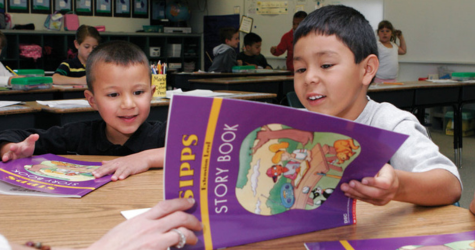Why should districts include a pilot as part of their curriculum adoption process?
The process of researching, evaluating, and selecting a new curriculum is a high-stakes and complex undertaking. Districts must ensure that the curriculum they select does in fact meet the needs of students and staff.
One powerful tool to ensure a great outcome is a pilot — when a district works in partnership with a curriculum provider to experience a curriculum with their educators and students.
In this first installment of a two-part series, we discuss the definition of a pilot and learn why choosing to pilot a curriculum is a worthwhile investment for district leaders, educators, and students. In the second blog, we will share insights from districts that have piloted programs in partnership with Collaborative Classroom.
Finally, we invite you to register for the January 2025 webinar, Investing in a Pilot to Find the Ideal Fit: How Piloting Benefits the Curriculum Adoption Process.
What Is a Pilot?
Collaborative Classroom defines piloting as an opportunity to fully understand the organization, content, and pedagogy of a curriculum and to see the results in a school community before deciding to adopt the curriculum.
During a pilot, educators engage in the instruction with their own students, allowing them to experience the impact of the programs and professional learning on teacher practice and student learning.
Collaborative Classroom defines piloting as an opportunity to fully understand the organization, content, and pedagogy of a curriculum and to see the results in a school community before deciding to adopt the curriculum.
To truly meet the needs of a district, its educators, and its students, every pilot will be unique in some way. Piloting a curriculum will look different for each school or district, depending on factors such as specific goals, time, budget, and the number of teachers who are piloting.

Why Piloting Is Essential to a Strong Curriculum Adoption Process—and Beyond
Let’s explore some reasons why conducting a pilot will benefit a district’s curriculum adoption process.
Ensuring the curriculum aligns with a district’s vision and goals
Every school district has its own vision and goals for teaching and learning. Piloting can help leaders and educators confirm whether a curriculum that looks promising on paper does in fact align with their vision and goals.
Experiencing the quality of the professional learning offered with the curriculum
Piloting a curriculum allows the district to experience and evaluate the quality of its accompanying professional learning, providing insights into questions such as:
- How thoughtful and comprehensive is the professional learning?
- How well does it meet educators’ needs?
- What additional supports might be necessary if the curriculum is adopted?
The professional learning experience during the pilot can give educators a preview of what professional learning will look like during implementation.
A pilot can help district leaders gauge the quality and strength of a potential long-term partnership with the curriculum provider.
Finally, a pilot can help district leaders gauge the quality and strength of a potential long-term partnership with the curriculum provider. How responsive is the curriculum provider? How committed are they to the success of the district’s teachers and students?
Surfacing important questions about a curriculum in a timely way
Piloting can help educators examine the ins and outs of a curriculum, surfacing important questions that might not otherwise be addressed during the curriculum adoption process. The hands-on experience of teaching lessons, administering assessments, and digging into teacher’s manuals is guaranteed to lead to a deeper understanding of the pedagogy and instruction.
Piloting can help educators examine the ins and outs of a curriculum, surfacing important questions that might not otherwise be addressed during the curriculum adoption process.
During a pilot, districts have access to curriculum experts who can answer questions or concerns that may come up during a potential implementation. By addressing these questions in a timely way and with a smaller group of educators—during a pilot versus during a full implementation—the overall process runs more smoothly.
Observing how students experience the curriculum and how well they succeed
A pilot allows district leaders and classroom teachers to clearly observe how their students respond to and engage with a curriculum.
When students experience the lessons first hand, they are truly piloting the curriculum just as much as their teachers. By observing their students, educators can ask and answer questions such as the following:
- Are students engaged?
- Are they learning—and then retaining that learning?
- Is the curriculum moving students toward becoming independent learners?
Every district will have its own key questions that a pilot can help answer. In any case, the responses to such questions are vital to a robust curriculum adoption process.
If time permits, educators can also collect valuable feedback from students.

Observing how educators experience the curriculum and how it affects teacher practice
Teachers who participate in a pilot will gain firsthand knowledge of whether the lessons and assessments are rigorous enough for students. By piloting, they will also be able to determine whether the curriculum is sufficiently supportive of teachers as they scaffold instruction for diverse learners.
In addition, leaders can ask questions such as:
- What do educators notice about delivering the instruction?
- How does the curriculum impact their educators’ own teaching practice and facilitation?
Setting a strong foundation for successful implementation
When a district pilots a curriculum and then decides to adopt it, they are already on the road towards a successful implementation.
The teachers who piloted become the first line of implementation support, thanks to their hands-on prior knowledge of the program. This creates a model of “teachers teaching teachers” that builds a confident and knowledgeable community of early implementers who will become leaders in their given school’s future implementation.
This creates a model of ‘teachers teaching teachers’ that builds a confident and knowledgeable community of early implementers who will become leaders in their given school’s future implementation.
Ensuring the best outcome to the curriculum adoption process
After piloting, districts can feel confident about the high-stakes decision of which curriculum to adopt and implement. Piloting makes this tough decision easier.
Leaders Share Insights About Piloting: Learn More
Stay tuned for part two of this blog series, in which we share insights from educators about their piloting experiences, including:
- Why they chose to pilot
- How piloting teachers were chosen
- What rubric they used in guiding their decision
- How long they piloted
- Other vital steps they took to ensure they chose a curriculum that fits the needs of teachers and students
Finally, be sure to register now for the upcoming panel-discussion webinar, Investing in a Pilot to Find the Ideal Fit: How Piloting Benefits the Curriculum Adoption Process, on January 30, 2025. In this webinar, leaders from around the country will discuss their pilot experiences with Collaborative Classroom.
Related Reading
Blog: Key Factors to Ensure a Successful Curriculum Review
Blog: Navigating Year One: Tips for a Successful Curriculum Implementation Journey
White Paper: What Are the Features of High-Quality Professional Learning?
